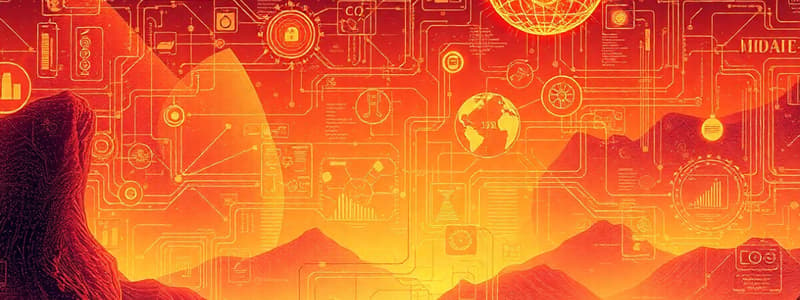Podcast
Questions and Answers
Which file organization method is most suitable for applications requiring the processing of data in a predefined order?
Which file organization method is most suitable for applications requiring the processing of data in a predefined order?
- Direct File Access Method
- Direct/Random File Organization
- Sequential File Organization (correct)
- Index Sequential Access Method
Which characteristic is least descriptive of Enterprise Resource Planning (ERP) systems?
Which characteristic is least descriptive of Enterprise Resource Planning (ERP) systems?
- Focus on integrating business processes in manufacturing
- Use of databases, processes, and rules
- Handling of financial accounting systems
- Emphasis on telecommunications infrastructure (correct)
In the context of information systems, which element primarily defines how work is structured and executed to create a valuable product or service?
In the context of information systems, which element primarily defines how work is structured and executed to create a valuable product or service?
- Business Process (correct)
- Organization
- Data
- Telecommunications
What is the primary objective of 'strategy' in the context of information systems and organizational management?
What is the primary objective of 'strategy' in the context of information systems and organizational management?
Which of the following components of an information system is responsible for providing instructions that tell the computer how to process data?
Which of the following components of an information system is responsible for providing instructions that tell the computer how to process data?
How do Management Information Systems (MIS) uniquely contribute to organizational success?
How do Management Information Systems (MIS) uniquely contribute to organizational success?
Which file access method relies on mathematical calculations using a primary key to locate records?
Which file access method relies on mathematical calculations using a primary key to locate records?
What is an example of how IT innovation reshapes the traditional business environment?
What is an example of how IT innovation reshapes the traditional business environment?
In information systems, what differentiates 'data' from 'information'?
In information systems, what differentiates 'data' from 'information'?
What role do 'people' play within an organizational information system?
What role do 'people' play within an organizational information system?
Which scenario exemplifies the most critical failure in an information system concerning timeliness?
Which scenario exemplifies the most critical failure in an information system concerning timeliness?
An organization is implementing a Customer Relationship Management (CRM) system. Which of the following strategies would MOST effectively leverage the system to enhance long-term relationships?
An organization is implementing a Customer Relationship Management (CRM) system. Which of the following strategies would MOST effectively leverage the system to enhance long-term relationships?
A hospital implements a new expert system to aid in diagnosing rare diseases. If the system consistently overlooks a specific set of subtle symptoms that indicate a particular condition, what aspect of the system requires immediate attention?
A hospital implements a new expert system to aid in diagnosing rare diseases. If the system consistently overlooks a specific set of subtle symptoms that indicate a particular condition, what aspect of the system requires immediate attention?
In the Systems Development Life Cycle (SDLC), which activity is MOST crucial for preventing cost overruns and ensuring the final product aligns with stakeholder expectations?
In the Systems Development Life Cycle (SDLC), which activity is MOST crucial for preventing cost overruns and ensuring the final product aligns with stakeholder expectations?
An organization is adopting an agile development approach for a new project. Which practice should be adopted to ensure alignment with user needs and iterative improvement:
An organization is adopting an agile development approach for a new project. Which practice should be adopted to ensure alignment with user needs and iterative improvement:
Which of the following represents the MOST significant challenge when transitioning from a waterfall model to an agile development methodology?
Which of the following represents the MOST significant challenge when transitioning from a waterfall model to an agile development methodology?
A supply chain management (SCM) system is experiencing failures in delivering products on time. Which diagnostic approach would be MOST effective in identifying the root cause of these delays?
A supply chain management (SCM) system is experiencing failures in delivering products on time. Which diagnostic approach would be MOST effective in identifying the root cause of these delays?
A company's transaction processing system (TPS) experiences a data breach. Which measure would MOST effectively mitigate the risk of future breaches?
A company's transaction processing system (TPS) experiences a data breach. Which measure would MOST effectively mitigate the risk of future breaches?
When designing a system, defining system boundaries is critical. What is the MOST important outcome of clearly defining these boundaries?
When designing a system, defining system boundaries is critical. What is the MOST important outcome of clearly defining these boundaries?
In the context of system feedback, which action BEST demonstrates a proactive approach to improving a business intelligence system's accuracy?
In the context of system feedback, which action BEST demonstrates a proactive approach to improving a business intelligence system's accuracy?
Flashcards
Data
Data
Raw facts or figures representing specific observations or entities.
Information
Information
Organized and processed data that provides context and meaning.
Timeliness
Timeliness
The characteristic describing how current and up-to-date information is.
System
System
Signup and view all the flashcards
Input
Input
Signup and view all the flashcards
Output
Output
Signup and view all the flashcards
Transaction Processing System (TPS)
Transaction Processing System (TPS)
Signup and view all the flashcards
Supply Chain Management (SCM)
Supply Chain Management (SCM)
Signup and view all the flashcards
Decision Support System
Decision Support System
Signup and view all the flashcards
Systems Analysis
Systems Analysis
Signup and view all the flashcards
DBMS (Database Management System)
DBMS (Database Management System)
Signup and view all the flashcards
Sequential File Organization
Sequential File Organization
Signup and view all the flashcards
Direct/Random File Organization
Direct/Random File Organization
Signup and view all the flashcards
Index Sequential Access Method
Index Sequential Access Method
Signup and view all the flashcards
Direct File Access Method
Direct File Access Method
Signup and view all the flashcards
ERP (Enterprise Resource Planning)
ERP (Enterprise Resource Planning)
Signup and view all the flashcards
Organization
Organization
Signup and view all the flashcards
Software
Software
Signup and view all the flashcards
Business Process
Business Process
Signup and view all the flashcards
Study Notes
- Data represents specific facts like numbers and statements
- Information is a collection of data
Characteristics of Information
- Timeliness: Information must be up-to-date
- Appropriateness: Information needs to be relevant
- Accuracy: Information should be correct and precise
- Conciseness: Information needs to be minimal, detailed, and relevant
- Understandability: The format of information is important
- Completeness: Incomplete information leads to bad decisions
System Concepts
- System: Interrelated components working together
- Input: Information users add to the system
- Output: Information processed and displayed
- System Boundaries: The scope of activities within a system
- Subsystems: Every system has subsystems that use resources to meet goals
- Subsystem Interface: Connects each system and subsystem
- System Environment: Receives data from the system
- System Feedback: The system needs feedback to process accurately
Types of Information Systems
- Information Systems: Collect data, process it, and display it to support decision-making
- Transaction Processing System: A widely used system that records data collected
- Supply Chain Management: A system that manages the sequence of marketing and manufacturing activities
- Customer Relationship Management System: A system that manages the relationship between an organization and its customers
- Business Intelligence Systems: It helps organizations compete
- Decision Support System: A system that answers "What if?" questions
- Expert Support System: Uses AI to store knowledge
Systems Life Cycle Stages and Activities
- Systems Development Life Cycle (SDLC): Also called waterfall development, follows well-defined phases
- Systems Analysis: The first stage in the system's life cycle; it analyzes data and identifies problems
- System Design: Describes how the system will fulfill its objectives
- Programming: Specifications are turned into code/program
- Testing: Tries to make the system fail
- Implementation: Referred to as delivery, including training
- Production and Maintenance: Reviewed by users and tech specialists
Approaches to System Development
- AdHoc Development: Relies on skills and experience of individual staff
- Waterfall Model: A common and early structured system development approach
- Prototyping: Builds a simplified version of a proposed system
- Spiral Model: Incorporates the best features of prototyping and the waterfall model
- Agile Development: Focuses on fast delivery; divides a large project
Managing Data Resources
- Database Management System (DBMS): Collects and manages data efficiently
Organizing Data
- Sequential File Organization: Processes information in a sequence
- Direct/Random File Organization: Uses magnetic disks
- Index Sequential Access Method: Stores records using primary keys
- Direct File Access Method: Uses the primary key with mathematical calculations
Enterprise Resource Planning (ERP)
- Integrates business processes in manufacturing
- ERP is dominated by large and expensive software packages
- Handles all financial accounting systems
- Emphasizes purchasing, human resource management, and investment management
- Uses databases, processes, and rules
- Strength: Handles data for large companies
Information Systems, Organizations, and Business Processes
- Organization: A stable, formal social structure
- Data: Input that the system takes to produce information
- Hardware: Computers and peripherals
- Software: Sets of instructions that tell a computer how to handle data
- Telecommunications: Involves both hardware and software for fast transmission
- People: Information systems professionals, and users to analyze organization
- Procedures: Rules for secure operations
- Business Process: How work is organized to produce a valuable product
Management Information Systems (MIS)
- Deals with behavioral and technical issues
IT Innovation
- Stream of IT innovation transforms the traditional business world.
New Business Models
- Emergence of online video streaming services
Strategy
- Determination of basic long-term goals
Studying That Suits You
Use AI to generate personalized quizzes and flashcards to suit your learning preferences.




